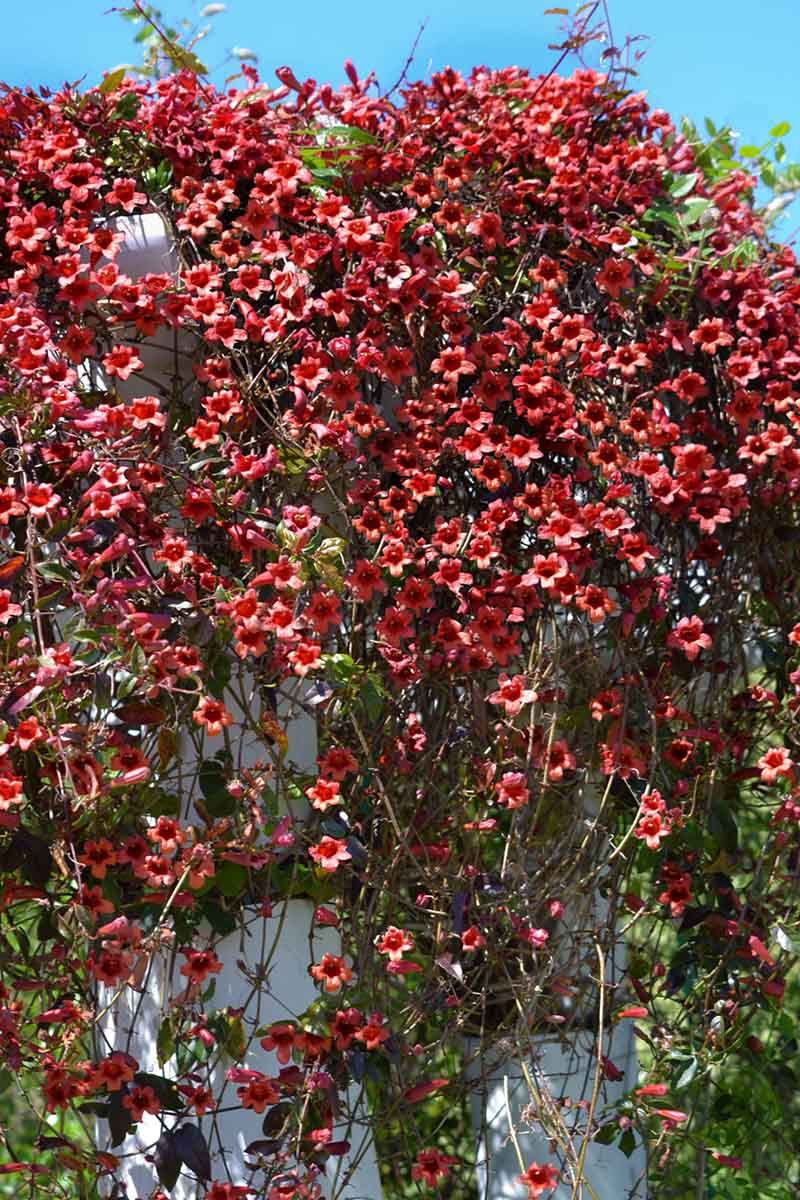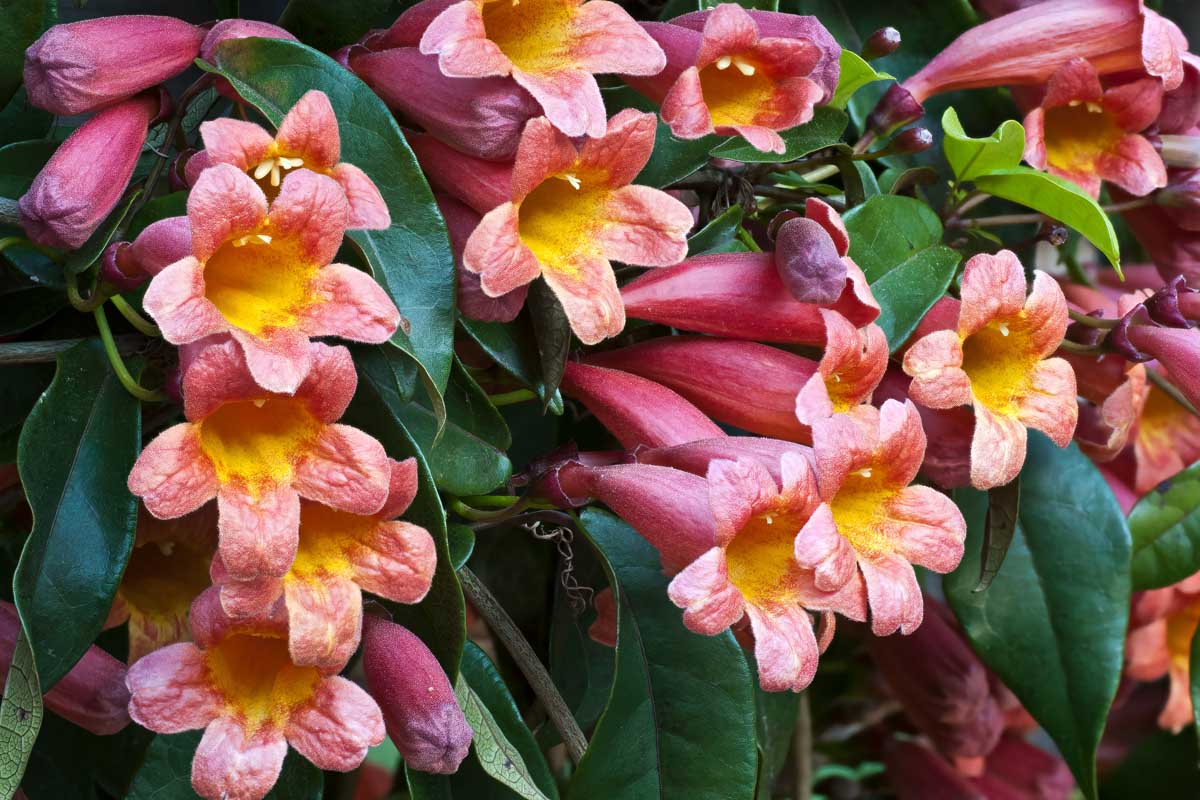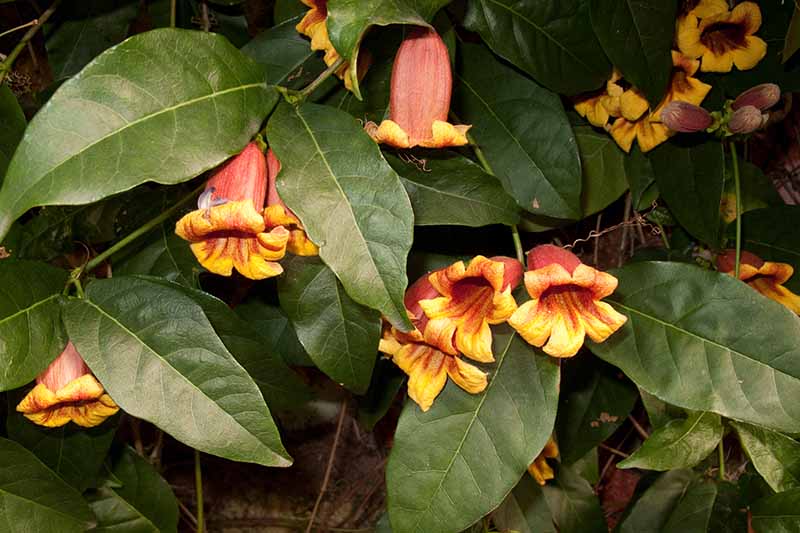Bignonia capreolata
Years after the fact, I remain flummoxed as to why my neighbor Daniel – an otherwise normal, rational person – ripped down and pulled out a spectacular, 20-foot-tall labyrinth of colorful crossvine that was growing on a trellis he had built up against his house.
Crossvine is a fast-growing climbing vine that can reach 50 feet tall. In early spring, it produces clusters of showy orange-red, sometimes yellow, trumpet-shaped flowers against a background of four- to six-inch-long glossy leaves.
When new leaves appear, they’re a light green color. As they mature and summer progresses, they deepen to a dark green. And then in winter some, but not all, of the leaves turn reddish-purple.

We link to vendors to help you find relevant products. If you buy from one of our links, we may earn a commission.
Crossvine is native to forested areas of east Texas, as well as parts of the southeastern, eastern, and midwestern United States.
But back to my neighbor. I never did get a good answer out of him. I think he was just tired of it.
Tired of the low-maintenance, evergreen perennial that was a neighborhood conversation piece? Okay, Lieutenant Dan.

I think fighting so many fires throughout his career with the Austin Fire Department must have fried his brain… (Just kidding, Dan!)
Don’t be like Daniel. Plant a crossvine, watch it grow, and then let it be. This article will teach you how to do that. Here’s what’s ahead:
What You’ll Learn
What Is Crossvine?
Bignonia capreolata is sometimes called trumpet vine or quarter vine.
Botanically, you may hear it referred to as Anisostichus capreolata, Doxantha capreolata, or Anisostichus crucigera, though these names are now considered taxonomically incorrect.

The common name “crossvine” is thought to have come from the appearance of a cross-cut section of the plant’s stem. The genus name “Bignonia” honors the librarian of French King Louis XV.
The Creek, Koasati, and Seminole indigenous peoples of what is now Florida, as well as the Houma of Louisiana, used crossvine roots and bark as a remedy for numerous medical conditions, including headaches, edema, rheumatism, and diphtheria.
Propagation
B. capreolata can be propagated from seeds and softwood cuttings.
From Seed
Purchase seeds or collect them from existing plants when the four- to eight-inch-long seed pods are light brown, in late summer or early fall.
You can store the seeds in an airtight container in the refrigerator for about a year.

Crossvine seeds don’t need any special preparation, and you can expect a 90 percent germination rate, more or less.
Plant seeds in a well-draining planter containing a mixture of peat, coarse sand, and perlite. Bury each seed one to two inches deep and water well.
Keep the soil moist but don’t overwater. Expect germination within three weeks.
Transplant seedlings into the garden when they are two to three inches tall and all risk of frost has passed.
You can direct sow outdoors in fall, or in spring after the last frost.
From Cuttings
To propagate crossvine from cuttings, use a sharp, clean cutting implement to cut off a healthy, six- to eight-inch stem in late spring or early summer.

Prepare a well-draining container with growing medium. Insert a pencil in the soil and remove it to create a hole for planting.
Remove leaves from the bottom two inches of the stem and treat the cut end with a powdered rooting hormone. Insert the cutting into the prepared container.

Create a terrarium effect by placing a plastic bag over the potted cutting, and securing it to create an enclosed environment.
The cutting will take about six to eight weeks to root and be ready to transplant into the garden.
From Seedlings or Transplanting
Plant into a hole the same depth as the container from which you are transplanting. Once the seedling is settled in its new home, add mulch to cover the planting area, and water well.
How to Grow
Though this plant is generally considered appropriate for USDA Hardiness Zones 6-9b, it may survive in Zone 5, albeit with possible leaf loss.
Crossvine grows best in full sun but will tolerate some shade, although there will be fewer flowers. It prefers soil with a pH of 6.8 to 7.2.
B. capreolata likes consistently moist but well-drained, organically rich soil, but it will tolerate standing water for short periods. It is also drought-tolerant once established.

Deer will snack on this one, so keep that in mind when it comes to site selection.
This plant can spread somewhat aggressively via suckers, so you might want to keep an eye out for those.
Fertilize crossvine with organic NPK 8-5-5 fertilizer early in spring before it flowers and then again after the blooms fade.
Growing Tips
- Plant in full sun
- For best results, water regularly
- Fertilize before and after flowering
Pruning and Maintenance
Prune for size as desired. You can choose not to prune and it will do just fine. But if it’s crawling over the entrance to the shed, for example, prune away.
Just wait until after it blooms in the spring to do your cutting, as crossvine blooms on old wood.
Cultivars to Select
Here in Austin, the cultivar I see the most often is ‘Tangerine Beauty.’ It’s an older cultivar that displays red-orange flowers with yellow throats.
Find live ‘Tangerine Beauty’ plants in one-gallon containers available from FastGrowingTrees.com.
If you need a vine that won’t grow to reach aircraft cruising altitude, consider ‘Astrosanuinea,’ a cultivar with dark purplish-red flowers that only gets to be 15-30 feet tall.
Displaying bright orange flowers, ‘Jekyll’ was selected on Jekyll Island in Georgia. It is more cold hardy than other crossvine cultivars.

Another “shorter” variety to consider is ‘Dragon Lady,’ which displays red or orange flowers with a bit of yellow in the throat, and reaches 20-35 feet tall at maturity.
‘Helen Fredel’ is well-liked because of its large, two-inch orange flowers with yellow throats.
And finally, ‘Wabash Valley’ produces maroon flowers with yellow throats, and ‘Shalimar Red’ offers coral-red flowers. Check your local garden center for these and other colorful cultivars.
Managing Pests and Disease
Crossvine has no serious insect or disease problems. Rarely, it might be pestered by any of a few types of fungi.
You may see leaf spot – small speckles of brown, tan, or black – which are often caused by the fungus Cercospora capreolata.
You might also see blight caused by the fungus Botrytis. Blight presents on leaves or stems as dark areas with concentric rings.
Black mildew caused by the fungi Dimerosoporium tropicale or Meliola bidentata may also develop. Treat any of these fungal diseases with a fungicide.
As mentioned above, deer also enjoy browsing this vine in wintertime. Find tips for dealing with deer here.
Best Uses
This vine likes to scramble vertically, so place it next to a wall, fence, or arbor – some place where it can climb to its heart’s content and put on a stunning display of blooms in season.
Quick Reference Growing Guide
| Plant Type: | Perennial evergreen vine in native habitat | Flower / Foliage Color: | Orange, red, yellow; green |
| Native to: | Texas, Midwest, Southeastern United States | Maintenance: | Low |
| Hardiness (USDA Zone): | 6-9b | Tolerance: | Drought, brief boggy conditions with standing water |
| Season: | Early spring | Water Needs: | Moderate |
| Exposure: | Full sun, partial shade | Soil Type: | Organically rich |
| Spacing: | 6 feet | Soil pH: | 6.8-7.2 |
| Planting Depth: | Same as transplant container | Soil Drainage: | Well-draining |
| Height: | 50 feet | Companion Planting: | Swamp jessamine |
| Spread: | 6-9 feet | Uses: | Structure ornament |
| Growth Rate: | Fast | Family: | Bignoniaceae |
| Attracts: | Bees, butterflies, deer in winter, ruby-throated hummingbirds | Genus: | Bignonia |
| Pests & Diseases: | Deer; black mildew, blight, leaf spot | Species: | capreolata |
Don’t Be Like Daniel: Embrace This Low-Maintenance Flowering Vine
If you’re looking for a quick-growing, low-maintenance, evergreen vine that will withstand heat and drought, consider crossvine.
And once it becomes established, don’t be like my neighbor Dan and tear it all down for no discernable reason.
Let it grow and flourish. Trim it up a bit if it’s encroaching on the neighbors’ but otherwise just leave it be!

Have you ever grown crossvine? Share your tips in the comments section below, and tell us about your favorite cultivars.
Looking for more information about growing other types of vines? Check out these articles next:



I’m so happy to have found all this information. I’ve noticed the trumpet shaped flowers intertwined in trees in my backyard, and for years I just assumed it was something invasive, but I liked it anyway, so I let it be. Now knowing that it was planted with a purpose and is such a great plant, I can’t wait to collect the seeds and plant in more places in my yard. The cultivar I have is Tangerine Beauty, and noticed you said it’s an older variety. Just how old are we talking? My house is 120 years old, and the… Read more »
What a delightful garden find. We’re so glad you got in touch! Where are you located, Christy? Are you in San Antonio, by any chance? Referred to often as one of the “older” cultivars and perhaps the most popular one, I thought it was strange to find online that there are so few references to the history of ‘Tangerine Beauty.’ So I did a bit of digging… All the USDA NRCS plant database had to offer was a brief statement, claiming this was one of several cultivars “bred for flower color, flower and leaf size, and winter hardiness.” I was… Read more »
Thank you for so much helpful information. I just planted my first tangerine beauty and although it’s quite big already I’m looking forward to watching her grow and bloom.
You’re welcome, Donna! We’d love to see photos when she does!
Hi there! Hoping you can help!
My cross vines I planted are dying. I’m so confused!
I live in Phoenix, AZ and planted them in mid/late Feb.
They have since not grown much, and only deteriorated. Dying from the top down.
They get full sun. I water (drenching the ground) once daily. I used to do it in the evening but I’ve tried to switch it up to the morning with no luck.
Please help! They were so expensive and I’d hate to kill these pretty things!
It sounds like overwatering may be the issue here. Are the vines planted in well-draining soil? Watering at night can introduce conditions that promote fungal growth, so switching to the morning was a good idea. I’d suggest carefully digging up the roots, and taking a look. If they appear healthy, try watering less frequently, and prune away the dead or dying portions of the vines. A soil test may also help to determine the nutritional makeup and pH of your soil, and amend accordingly as needed.
Thank you for the information on the sensitivity to over-wet conditions or overwatering. One note is that the 8th photo is a trumpet vine, not cross vine. I much prefer cross vine, having had trumpet vine at my previous home and battled to prune and control it.
Hi Beverly, good catch, thank you! I’ve removed that photo. Happy Gardening!
I’m a landscape designer and use this species all the time. It’s a great garden-worthy plant when used in the right place. Good article, with just a coupla nitpicks: First, your pic of ‘Tangerine Beauty’ is not a picture of that cultivar. The big pic in the How to Grow section looks a lot more like ‘Tangerine Beauty,’ at least every ‘TB’ I’ve ever grown (was a professional propagator for years and grew thousands of these) or bought. Also, the pic in the What is Crossvine? section is actually a shot of Campsis radicans, the related Trumpet Creeper. Here’s a… Read more »
Hi there! How wide does this vine get? Can I direct some of the 50′ of height sideways on a wide trellis (like 7′ or so)? I would like to cover much of a 6′ block wall, but of course the linear footage is much longer than it is tall. Thank you!
Hello Aubrey! The crossvine spreads six to nine feet, and as you probably read in this article, it will attach to the block wall without added supports. You probably couldn’t direct the height sideways, but you can prune crossvine after it finishes blooming in spring so that it doesn’t get higher. At the same time, allow the spread to continue without pruning. It should fill out your space quite nicely! If you do prune it, keep in mind that it blooms on the old wood, so don’t cut back so much that you don’t get blooms the following season. Good… Read more »
Thanks for the catch Marty!
I planted a tangerine cross vine in a large pot with good drainage in July. It is on a south facing deck, zone 10 in so. California. The leaves have all turned purple and look wilted. Is it dying or just dormant? Should I soak it well and hope for the best or try something else? 25 to 30 degree temp fluctuation in winter. (45 to 75 right now.
It’s not uncommon for leaves to change reddish-purple in the fall for some varieties, so I wouldn’t worry too much about that. These are winter hardy in warm zones, and they should be able to survive temperatures colder than what you’ve described. Are the leaves uniformly purple, or do they have spots? Are the leaves falling off? Can you share photos? We’d love to help you to get to the bottom of this!
My beautiful crossvine was ripped from my fence by a 60 mph wind in a storm yesterday!
Can I reattach it? It would be no problem to string the vines back up, but will they grow new attachments to the fence? If I prune them back to the trellis I will lose 1.5 years growth.
Thank you.
Sorry to hear about the storm, Paulette! Fortunately crossvine grows quickly. If it’s still producing those tendrils that eagerly latch on to the fence, it may reattach itself with some help. But if you notice that parts of the growth that was knocked down is broken or dying off, it would be a better idea to trim away the damaged portions.
I planted a tangerine beauty crossvine last summer to cover a trellis (in zone 6). It started out about 2 feet tall grew to about 6 feet with few blossoms. It looks fully dead after the winter. Is likely to come back?
Hello Mark! I have high hopes for this crossvine, but can’t say definitely that it will come back. There’s every possibility that the roots did survive the cold weather, and that it will blossom forth again this spring. So give it a bit of time, and keep your fingers crossed. Also, if you remember later, let us know how it goes.
I know crossvine is said to need no support to climb like a trellis or arbor, etc. However, I’ve planted a few along a brick perimeter fence hoping they’ll climb and cover the brick wall but every time they do start to climb up, they’ll eventually detach and fall back down so now I have pretty long vines just laying on the ground next to the wall. There are some that have attached pretty good but it seems any time there’s some wind, the really long ones will detach. Any advice?
Hello Cynthia! Could you give me an idea of how tall this wall is? I feel like it may be that they want to grow higher than the support allows. If that is the case, you might want to try a trellis that’s a bit higher in front of the wall. As for those long vines, I would prune them off, but wait until they’re done blooming in the spring. Maybe the combination of sturdier vines and a taller support will do the trick. It would be great if you’d get back to me later and say if this worked.… Read more »
Rose
I plan to do something similar to Cynthia and have a crossvine grow up about a 12×6 back of brick fireplace – and if it spills over around the corners and attaches to the sides of the fireplace that would be an added bonus. Do you think a a shorter pot trellis would be advisable to give it a good start? I prefer to stay away from trellis altogether.
Hello Wes! That crossvine design sounds wonderful. I do think some sort of support at the bottom might help, at least the first season or two. I’d favor something sturdy but not massive, like a cross-hatched wooden panel with openings that are a couple of inches long. If you’d prefer to avoid a trellis but are worried the vines won’t attach to the bricks on their own, you might want to consider hanging a panel of sturdy wire mesh, like chicken wire with one or two-inch openings, to the back of the fireplace. That will help the vines get the… Read more »
Cynthia
I am curious if you ever got the vine to self-climb the brick wall? I am planning to do the same thing with and outdoor fireplace – set a potted crossvine at its base and let it climb. I’m considering the following in order of preference: 1) no trellis, 2) short trellis to give it a start, or 3) tall trellis.
Wes in Arkansas.
You neighbor Dan being a firefighter may have known that it’s a huge fire hazard. It’s not recommended to have it growing near your house.
That is a potential reason to get rid of crossvine for sure, Ember. Thanks for sharing,
Our crossvine has been beautiful for several years (pictures attached). Just now we have one that definitely looks like it is dying & ones near it are starting to look droopy. They are getting blackish/purplish spots on the leaves (young leaves & older leaves, pictures attached). I’m so afraid I’m gonna lose all the crossvines. I’ve read maybe spider mites & maybe fungus. I’ve also read that people have tried fungicide & no better. Is there a specific fungicide to use??
Can you try uploading your photos again, Tracy? And where are you gardening?
Spider mites are hard to see, but they will typically leave telltale webbing behind. If it is a fungal issue, a lack of sunlight and poor airflow could be at play, exacerbating disease issues.